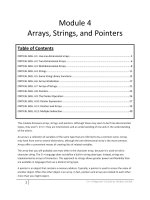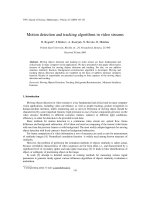Pointers. Arrays. Strings. Searching and sorting algorithms.
Bạn đang xem bản rút gọn của tài liệu. Xem và tải ngay bản đầy đủ của tài liệu tại đây (135.31 KB, 4 trang )
Massachusetts Institute of Technology
Department of Electrical Engineering and Computer Science
6.087: Practical Programming in C
IAP 2010
Problem Set 4
Pointers. Arrays. Strings. Searching and sorting algorithms.
Out: Friday, January 15, 2010. Due: Tuesday, January 19, 2010.
Problem 4.1
Consider the insertion sort algorithm described in Lecture 5 In this problem, you
will re-implement
the algorithm using pointers and pointer arithmetic.
(a) The function shift element() takes as input the index of an array element that has been
determined to be out of order. The function shifts the element towards the front of the array,
repeatedly swapping the preceding element until the out-of-order element is in the proper
location. The implementation using array indexing is provided below for your reference:
/∗ move p r e v i o u s el e m e nt s down u n t i l
i n s e r t i o n po i n t re a ch e d
∗/
void s h i f t e l e m e n t ( unsigned in t i ) {
int i v a l u e ;
/∗ guard ag a i n s t g oi ng o u t s i d e a r r ay ∗/
for ( i v a l u e = ar r [ i ] ; i && a r r [ i −1] > i v a l u e ; i −−)
a r r [ i ] = a r r [ i
− 1] ; move element down /∗ ∗/
a r r [ i ] = i v a l u e ; /∗ i n s e r t element ∗/
}
Re-implement this function using pointers and pointer arithmetic instead of array indexing.
/∗ i n t ∗ pElement − p o i n t e r to t he elem e n t
i n ar r ( type i n t [ ] ) th a t i s out
−of−p l a c e ∗/
void s h i f t e l e m e n t ( int ∗ pElement ) {
/∗ i n s e r t code he re ∗/
}
(b) The function insertion sort() contains the main loop of the algorithm. It iterates through
elements of the array, from the beginning, until it reaches an element that is out-of-order. It
calls shift element() to shift the offending element to its proper location earlier in the array
and resumes iterating until the end is reached. The code from lecture is provided below:
/∗ i t e r a t e u n t i l out−o f −o r d er el e ment found ;
s h i f t t h e element , and c o n t i n u e i t e r a t i n g
∗/
void i n s e r t i o n s o r t ( void ) {
unsigned in t i , l e n = a r r a y l e n g t h ( a r r ) ;
for ( i = 1 ; i < l e n ; i++)
i f ( a r r [ i ] < a r r [ i −1])
s h i f t e l e m e n t ( i ) ;
}
Re-implement this function using pointers and pointer arithmetic instead of array indexing.
Use the shift element() function you implemented in part (a).
1
Problem 4.2
In this problem, we will use our knowledge of strings to duplicate the functionality of the C standard
library’s strtok() function, which extracts “tokens” from a string. The string is split using a set of
delimiters, such as whitespace and punctuation. Each piece of the string, without its surrounding
delimiters, is a token. The process of extracting a token can be split into two parts: finding the
beginning of the token (the first character that is not a delimiter), and finding the end of the token
(the next character that is a delimiter). The first call of strtok() looks like this:
char ∗ strtok(char ∗ str, const char ∗ delims);
The string str is the string to be tokenized, delims is a string containing all the single characters
to use as delimiters (e.g. " \t\r\n"), and the return value is the first token in str. Additional
tokens can be obtained by calling strtok() with NULL passed for the str argument:
char ∗ strtok(NULL, const char ∗ delims);
Because strtok() uses a static variable to store the pointer to the beginning of the next token,
calls to strtok() for different strings cannot be interleaved. The code for strtok() is provided
below:
char ∗ s t r t o k ( char ∗ te x t , const char ∗ de li m s ) {
/∗ i n i t i a l i z e ∗/
i f ( ! t e x t )
t e x t = pnexttoken ;
/∗ f i n d s t a r t o f token i n t e x t ∗/
t e x t += s t r s p n ( t e xt , d el i m s ) ;
i f (∗ t e x t == ’ \0 ’ )
return NULL;
/∗ f i n d end o f token i n t e x t ∗/
pnexttoken = t e x t + s t r c s p n ( tex t , de l i m s ) ;
/∗ i n s e r t n u l l −te r m i n a t or at end ∗/
i f (∗ pnexttoken != ’ \0 ’ )
∗ pnexttoken++ = ’\0 ’ ;
return t e x t ;
}
(a) In the context of our string tokenizer, the function strspn() computes the index of the
first non-delimiter character in our string. Using pointers or array indexing (your choice),
implement the strspn() function. In order to locate a character in another string, you may
use the function strpos(), which is declared below:
int s t r p o s ( const char s t r , const char ch ) ; ∗
This function returns the index of the first occurrence of the character ch in the string str,
or -1 if ch is not found. The declaration of strspn() is provided below:
unsigned in t s t r s p n ( const char ∗ s t r , const char ∗ de li m s ) {
/∗ i n s e r t code he re ∗/
}
Here, delims is a string containing the set of delimiters, and the return value is the index of the
first non-delimiter character in the string str. For instance, strspn(" . This", " .") == 3.
If the string contains only delimiters, strspn() should return the index of the null-terminator
(’\0’). Assume ’\0’ is not a delimiter.
2
(b) The function strcspn() computes the index of the first delimiter character in our string.
Here’s the declaration of strcspn():
unsigned in t s t r c s p n ( const char ∗ s t r , const char ∗ d e l im s ) {
/∗ i n s e r t code he re ∗/
}
If the string contains no delimiters, return the index of the null-terminator (’\0’). Implement
this function using either pointers or array indexing.
Problem 4.3
In this problem, you will be implementing the shell sort. This sort is built upon the insertion sort,
but attains a speed increase by comparing far-away elements against each other before comparing
closer-together elements. The distance between elements is called the “gap”. In the shell sort, the
array is sorted by sorting gap sub-arrays, and then repeating with a smaller gap size.
As written here, the algorithm sorts in O(n
2
) time. However, by adjusting the sequence of
gap sizes used, it is possible to improve the performance to O(n
3/2
), O(n
4/3
), or even O(n(log n)
2
)
time. You can read about a method for performing the shell sort in O(n(log n)
2
) time on Robert
Sedgewick’s page at Princeton:
/>~
rs/shell/paperF.pdf
Note that you can find complete C code for the shell sort at the beginning of the paper, so please
wait until you have finished this exercise to read it.
(a) First, we will modify the shift element() function from the insertion sort code for the shell
sort. The new function, started for you below, should start at index i and shift by intervals
of size gap. Write the new function, using array indexing or pointers. Assume that i
≥ gap.
void s h i f t e l e m e n t b y g a p ( unsigned int i , unsigned in t gap ) {
/∗ i n s e r t code he re ∗/
}
(b) Now, we need to write the main shell sort routine. Using the template below, fill in the missing
code so that the insertion sort in the inner loop compares every element to the element gap
spaces before it.
void s h e l l s o r t ( void ) {
unsigned in t gap , i ,
l e n = a r r a y l e n g t h ( a r r ) ;
/∗ s o r t , comparing a g a i n s t f a r t h e r away
el e m e n t s f i r s t , then c l o s e r e le me n t s
∗/
for ( gap = l e n / 2 ; gap > 0 ; gap /= 2) {
/∗ do i n s e r t i o n −l i k e so r t , but comparing
and s h i f t i n g e l em en ts i n m u l t i p l e s o f gap
∗/
for i n s e r t code h e r e
( /∗ ∗/ ) {
i f ( /∗ i n s e r t code he re ∗/ ) {
/∗ out o f o r d e r , do s h i f t ∗/
s h i f t e l e m e n t b y g a p ( i , gap ) ;
}
}
}
}
3
MIT OpenCourseWare
6.087 Practical Programming in C
January (IAP) 2010
For information about citing these materials or our Terms of Use, visit: />.









